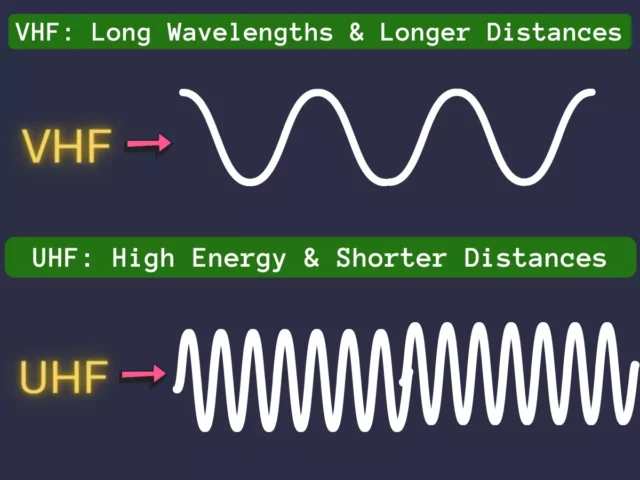Wireless communication utilizes various bands within the electromagnetic wave spectrum, ranging from low to high frequency. Among these, the VHF and UHF bands are commonly employed. In this article, we will explore the distinctions between these two bands.
Radio Frequency Bands and Frequency Ranges
| Band Name | Symbols | Frequency range |
|---|---|---|
| Very low frequency | VLF | 3 to 30 KHz |
| Low frequency | LF | 30 to 300 KHz |
| Medium frequency | MF | 300 to 3000 KHz |
| High frequency | HF | 3 to 30 MHz |
| Very high frequency | VHF | 30 to 300 MHz |
| Ultra High frequency | UHF | 300 to 3000 MHz |
| Super high frequency | SHF | 3 to 30 GHz |
| Extremely high frequency | EHF | 30 to 300 GHz |
| Terahertz (ITU,2015) | THz | 300 to 3000 GHz |
Radio Frequency Bands:VHF
VHF, or Very High Frequency, encompasses radio waves that have a frequency range from 30 MHz to 300 MHz, with wavelengths spanning from 1 to 10 meters. Primarily utilized for radio and television broadcasting, it also serves as a communication medium in aviation and navigation. VHF communications are well suited for long-distance transmission. Unlike high frequency (HF), VHF signals are not normally reflected by the ionosphere and their propagation can be affected by environmental factors such as terrain.
Radio Frequency Bands:UHF
Ultra High Frequency (UHF) denotes radio waves that have frequencies ranging from 300MHz to 3000MHz, corresponding to wavelengths between 1 meter and 1 decimeter. The UHF band is commonly referred to as the decimeter wave due to its characteristics. UHF operates with a channel count ranging from 13 to 68, utilizing frequencies between 920 MHz and 925 MHz. Certain radio and television applications frequently employ bands between 840 MHz and 845 MHz.
VHF VS UHF Difference
The main difference between the two lies in the frequency range and propagation characteristics. Due to the lower frequency of VHF, its signal propagation distance is farther and it has stronger ability to penetrate obstacles, which is suitable for long-distance communication, such as radio, television and aviation communication. On the other hand, UHF operates at a higher frequency, resulting in a shorter range of signal transmission and increased vulnerability to interference caused by obstacles. Therefore, it finds its primary application in radio communications as well as mobile communications, specifically for short-distance communication needs.

The decision to use VHF or UHF depends on specific needs and environmental conditions.
- VHF is the preferred option for long-distance communication or when operating in open areas.
- UHF is more suitable for short-range communication or when operating in urban or mountainous regions with many obstacles.
- VHF and UHF require different equipment and antennas due to their distinct frequency ranges.
VHF and UHF are the basic frequency ranges in the radio spectrum, each with its own advantages and suitable for different application scenarios. Choosing the right frequency range based on specific needs and environmental conditions can improve the effectiveness and reliability of communications. Understanding the difference between VHF vs. UHF is critical to making informed decisions in a variety of communication scenarios.
UHF Connectors
Now that we’ve grasped the difference between VHF vs. UHF, let’s explore a connector often used in UHF: the UHF connector.
Manufacturers design UHF connectors with a threaded connection that allows for a good seal when the user connects and disconnects. This type of connection allows UHF connectors to maintain a stable connection even in shock and vibration environments, and is suitable for a variety of harsh operating environments, including high temperature, low temperature, high humidity and corrosive conditions.
Applications for UHF Connectors
Radio communications and broadcasting equipment widely utilize this connector type. For example, mobile communication systems, radio stations, radio transceivers, and broadcast television equipment commonly employ UHF connectors. One of the reasons for its widespread use is its ease of use and cost-effectiveness, making it the connector of choice for many UHF devices.
UHF connectors are also widely used in industrial applications. Examples include wireless sensor networks, remote monitoring systems and industrial automation equipment. In industrial environments, communication devices usually have to face harsh working conditions and interference, and therefore need connectors that can stably transmit signals.UHF connectors meet the demanding requirements for reliable communication in the industrial field through their durability and good anti-interference capability.

Military communications are another important application area for UHF connectors. In military operations, security, reliability and timeliness of communications are critical.UHF connectors provide effective communication solutions for the military through their highly secure design and reliable performance. Military radio equipment, radar systems, navigation systems, and other military communication equipment widely employ them to ensure the efficient operation of information transfer and command on the battlefield.
In practical applications, the performance and reliability of UHF connectors are critical to the proper operation of communication systems. Therefore, the proper selection and use of high-quality UHF connectors, as well as regular maintenance and inspection, can ensure a stable connection between devices and provide excellent signal transmission performance, while reducing the risk of malfunction and disconnection.
Select UHF Connector
When selecting a UHF connector, it is important to match the needs of the specific application. There are several types of UHF connectors available, such as UHF PL-259 (Male) and UHF SO-239 (Female). To ensure compatibility and a stable connection with other devices, it is important to consider factors such as the performance specifications of the connector, the number of splices, and impedance matching.

As wireless communication technology continues to advance, UHF connectors are undergoing continuous improvements and upgrades to meet the demands of higher frequencies, wider bandwidths, and more intricate communication systems. Simultaneously, certain manufacturers have introduced multi-functional UHF connectors with features like detachable connectors and metal or plastic housing, enhancing their flexibility and ease of installation while offering more options and adaptability.
As a common and important connector type, UHF connectors provide a stable and reliable solution for connecting UHF devices. It plays a key role whether in communications, broadcasting, military, or other fields. When selecting UHF connectors, ensuring that you choose a model that suits the needs of your specific application, as well as guaranteeing its quality and performance, will help to build an efficient and stable communication system and promote the development of modern wireless communication technology.


